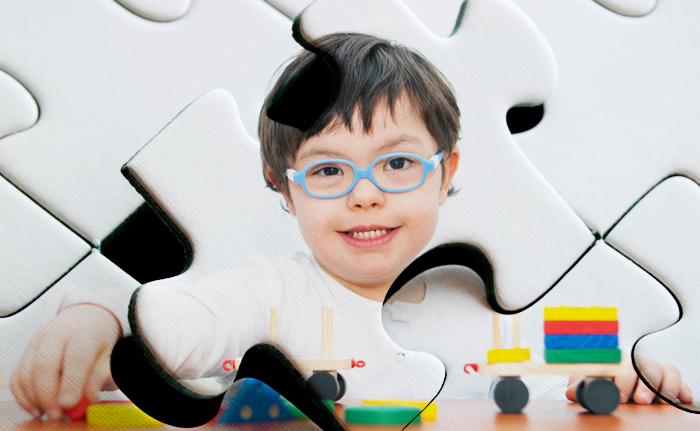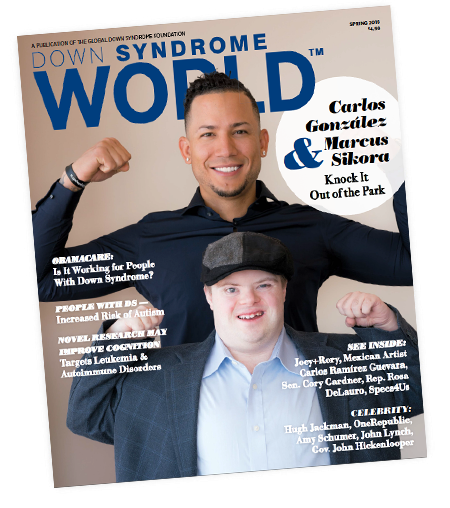Navigating a Dual Diagnosis of Down Syndrome and Autism

Finding out your child with Down syndrome has co-occurring Autism Spectrum Disorder (DS-ASD) can be daunting, but a better understanding of DS-ASD opens doors to resources and support that benefit children and families alike.
 Este artículo se publicó en el galardonado El mundo del síndrome de Down™ revista. Afiliarse para leer todos los artículos y recibir los próximos números en su domicilio.
Este artículo se publicó en el galardonado El mundo del síndrome de Down™ revista. Afiliarse para leer todos los artículos y recibir los próximos números en su domicilio. ACCORDING TO THE American Psychiatric Association, ASD is a complex developmental disorder that can cause problems with thinking, feeling, language, and the ability to relate to others. Symptoms occur on a spectrum ranging from mild to severe, and are characterized by challenges in social interaction, verbal and nonverbal communication, and repetitive behaviors.
Current research suggests between 8 and 18 percent of individuals with Down syndrome may also have autism. According to Sarah Hartway, R.N., M.S., President of the Board of Directors of The Down Syndrome-Autism Connection™, an additional 25 percent of people with Down syndrome may exhibit some autism symptoms but not with enough prevalence or severity to be diagnosed with DS-ASD.
“We know autism occurs more frequently in people who have other genetic or chromosomal anomalies,” Hartway said. “So it’s not surprising that people who have Down syndrome are more likely to have autism than the general population.”
SPOTTING THE SIGNS OF AUSTISM
“All children, at any given time, can exhibit behaviors that are consistent with autism, but a child with DS -ASD may engage in them more frequently or find them to be more problematic,” said Robin Zaborek, who also sits on The Down Syndrome-Autism Connection Board of Directors. “Number, frequency, and intensity of behaviors may be distinguishing factors in evaluating for DS-ASD.”
According to Zaborek, children with DS-ASD may engage in the following behaviors:
- Unusual vocalizations
- Repetitive motions, such as rocking or clapping
- Persistent, pronounced need for structure and routine
- Disinterest in playing with others
- Inappropriate laughing or crying
- Repetitive playing with an object, such as a wooden spoon
In some cases, children with DS-ASD may engage in dangerous behavior, such as running away, self-injury, or aggression. They may struggle to reach developmental milestones and have problems with eating, sleeping, and toilet training. They’re also more likely to have certain medical and behavioral conditions, including gastrointestinal issues, seizures, anxiety, and attention-deficit/hyperactivity disorder.
Fortunately, there are resources and ongoing research for people with ASD that will also benefit people with the dual diagnosis. But diagnosing DS-ASD can be a challenge. “Not all medical professionals are aware Down syndrome and autism can co-occur,”
“Not all medical professionals are aware Down syndrome and autism can co-occur,” said Margaret Froehlke, R.N., B.S.N., Secretary of the Board of Directors at The Down Syndrome-Autism Connection. “If families have a Down syndrome clinic in their community, the clinicians there would be better able to make a dual diagnosis because they have the appropriate background.”
Examples of such clinics include the Anna and John J. Sie Center for Down Syndrome at Children’s Hospital Colorado and the Thomas Center for Down Syndrome Services at the Cincinnati Children’s Hospital Medical Center.
Beyond such specialty Down syndrome clinics, Froehlke recommends parents visit a facility that belongs to the network of University Centers for Excellence in Developmental Disabilities, listed at aucd.org.
THE BENEFIT OF KNOWING
Parents of children with undiagnosed DS-ASD can feel very isolated, Froehlke said. They may look at how their child interacts with his or her peers with Down syndrome, and when their child isn’t developing in the same ways or at the same pace, they may pull away from their friends in the Down syndrome community.
“For me and many other parents, getting a dual diagnosis actually leads to relief and validation, because now you understand why your child is different,” she said. “You can begin to seek out the treatments, support, and interventions available to you.”
“There is a compassionate community of professionals and families out there who truly understand the DS-ASD journey is different,” Hartway added. “No one has to walk this path alone.”
¿Te gusta este artículo? Únase hoy mismo al programa de afiliación de la Fundación Global del Síndrome de Down para recibir 4 números de la galardonada publicación trimestral, además de acceso a 4 series de seminarios web formativos estacionales y la posibilidad de solicitar las becas de empleo y formación de Global.
Inscríbase hoy en downsyndromeworld.org!
Entradas recientes
- Clarissa Capuano y Midori Francis: Positividad y autenticidad
- Down Syndrome Regression Disorder vs a Mother’s Love: A Washington Post Mother’s Day Feature
- Alex y Anthony: Fuera de la caja, en el punto de mira
- LÍDERES GLOBALES - Entrevista exclusiva con Erin Suelmann, Directora Ejecutiva de la Down Syndrome Association of Greater St.
- Apnea del sueño a lo largo de la vida en personas con síndrome de Down

 Disfrute de nuestros vídeos y fotos inspiradores e innovadores. ¡Nuestros niños y autogestores son hermosos Y brillantes!
Disfrute de nuestros vídeos y fotos inspiradores e innovadores. ¡Nuestros niños y autogestores son hermosos Y brillantes! Asegúrese de que sus representantes locales forman parte del Grupo de Trabajo sobre el Síndrome de Down del Congreso.
Asegúrese de que sus representantes locales forman parte del Grupo de Trabajo sobre el Síndrome de Down del Congreso.